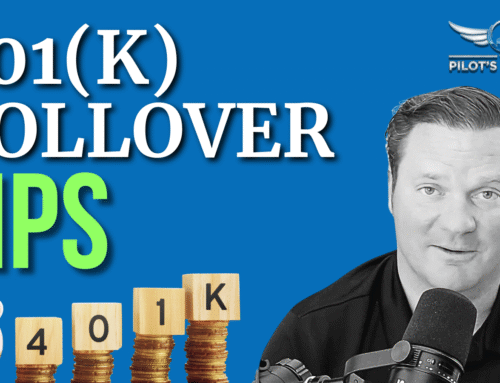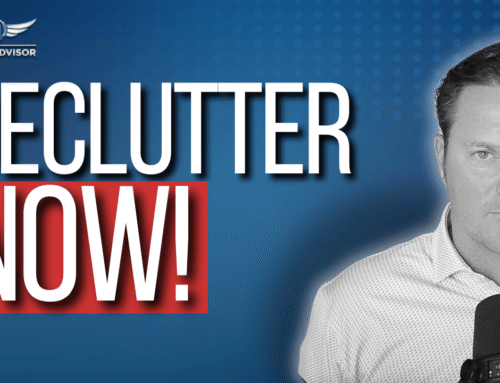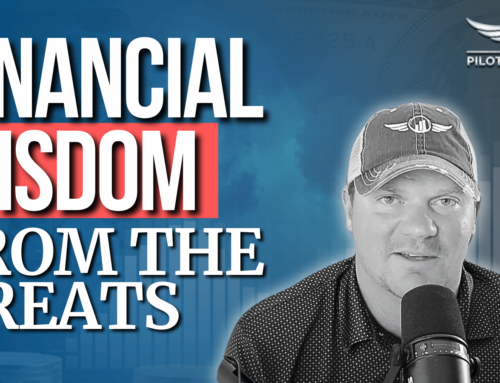Preview:
We’re excited to bring on Lee Hyder of Lee Hyder & Associates today to share insights and stories from 30+ years of experience. Join us as we go back and forth on the highs and lows investors face, underscoring the need for resilience and a long-term outlook when building a portfolio for retirement.
Subscribe On Your Favorite App:
More About This Episode:
We spend the first part of the episode discussing fees and how you should approach them with your investment portfolio. Who wouldn’t pay a percent or two to get an extra three or four percent return? That’s part of what you should be evaluating and we’ll get Lee’s insight on how he evaluates investments for clients. Plus, let’s take a look at the S&P 500 and why it isn’t the way to get true diversification in your portfolio.
Sky Snippets:
0:00 – Intro
0:49 – Howard Capital portfolios
7:21 – S&P 500
10:33 – Educating pilots
12:27 – Distribution phase
14:23 – Final wisdom from Lee
Resources:
Retire Pilots – https://retirepilots.com
Get your FREE Retirement Toolkit – https://bit.ly/3ZmZsaX
Pilot Tax – https://pilot-tax.com/
The Pilot’s Advisor Podcast is also on video. Watch & Subscribe on YouTube: https://bit.ly/3EIEBW2
Connect with Pilot-Tax: https://pilot-tax.com/
Episode Transcription:
(Note, this is an automated transcription. Please forgive any errors.)
Walter Storholt (Host) 00:01
Welcome to the pilots advisor with Ryan Fleming of first officer with FedEx on the triple seven at the hill. On this show will delve deep into tailored financial strategies, insights and wisdom crafted exclusively for those who rule the skies will help you navigate your financial flight plan with the same mastery you exhibit in the cockpit, prepare for takeoff into a journey of financial clarity and empowerment. The pilots advisor starts now. Hey, coming up on today’s edition of the pilots advisor Ryan Fleming is once again joined by Lee highter. They’re gonna continue their conversation about courageous investing and crafting philosophies around your retirement. So let’s kick things off by diving into the big hang up with Howard capital.
Ryan Fleming 00:48
All right, next topic of conversation. And this is gonna be a fun one. We talked a lot about Howard capital and their portfolios. And, and I know a lot of my investors on the outside of a 401k Want to get access to Howard. But the big hang up with Howard, the clients are going to go do their research and they look at the fees and they go, Oh my God, I want to get in that portfolio that has six basis points and guess what their fees are out of control. Now, the first thing I’m going to say is, Hey, Lee, all those returns are net of fees, that means all the expense ratios, and all those fees are paid out. And that’s the return, I was talking to a few people about this. And you know, you get what you pay for and I go would you be willing to pay, you know, 1.5 or 2%? To get an extra three or 4%? Every single year? And the answer to that should be yes. All day long. Sure. How do you justify when you look at the Howard portfolios when people when a client starts talking about fees? And and how they they view it and say, hey, the fees are way too high for this. It’s not performing even though they’ve been in the portfolio eight months? How do you how do you justify that?
Lee Hyder 01:59
Well, you know, first of all, I think what you said in the very beginning is is really the the cornerstone, you really get what you pay for. And number one, you know, I think I think people have been trained, we’re a little robotic, to say things to look for certain things, but we really don’t even know what we’re looking for, or why we’re asking the question. So I think people are very quick to say, well, those fees are high. But in essence, if you really do it in reverse if you take a look at the returns, and to me, that’s what it’s all about. You know, we have fi conversations, but when we talk about the returns that we historically had been able to produce, we’re not going to produce them every single year. I mean, clearly, as we know, as every brochure says, you know, you know, past performance is no guarantee of future performance. But historically, the numbers are there. So to me, we’ve not had a problem when clients really understand that. Yeah, you know, here’s a Vanguard portfolio, there’s certainly nothing of matter with it. And these are the fees. But these are the historic returns that this portfolio has achieved. These are the Howard capital portfolios, these are the returns the returns are just so much greater, that it really isn’t a fee conversation when they understand what they’re getting, and why the fees are higher. Well, they’re one of the reasons why the fees are higher is they’re doing more for you. And you know, you have to pay for activity. If you have a portfolio that is simply passive just sitting there collecting dust doing nothing. Well, I would hope it would be an inexpensive portfolio. But on the other side of the coin, you know, with the Howard capital byline, you know, getting in and getting out of the market at an appropriate time taking advantage of sector rotations and market momentum, things of this nature, you know, that takes more human interaction more activity, more keystrokes, which is inevitably more expensive. But you get what you pay for it and the returns don’t lie? Well,
Ryan Fleming 03:50
exactly. And access to the algorithm that’s been built out that takes a lot of money to keep it going. And all the analytics are involved in that. And so when I look at it, I go Yeah, return 25% You might have paid 2% and fees, but that means it actually returned 27% Because that’s 20 fives and out of all fees. So looking at the big picture, looking at it long term, and I actually had a conversation with Vance Howard himself about this. And I said, I said, Vance, you know, I mean, your returns are amazing, like what we done, it’s truly remarkable. How do you talk about the fees when you start looking at it? And he goes, You know what, if you want something passive and you want to go pay for the Vanguard, six basis points, 15 basis points portfolio, you’re gonna get very average returns. Sure, you know, if you want to be average, go to Vanguard, but if you want if you want exceptional returns, you’re going to have to pay for it. Right? And it’s going to take a trader that knows what they’re doing, that it’s going to understand leveraging who’s gonna understand momentum in the market, and then you’re gonna get exceptional returns.
Lee Hyder 04:54
And then there’s also a problem with people really understanding because, you know, they can look at a portfolio and say, well, this portion Oleanna looks very similar to yours. But it really doesn’t, you know, you can take to 3000 square foot homes, and they’re both 3000 square feet, they both have maybe three or four bedrooms, they’ve got beautiful kitchens, you know, but one house may actually sell for $150,000 more. And one of the reasons may be you don’t even see behind the scenes, you don’t see the difference in quality materials that they put in, in that house. So it’s the same thing in the portfolio, you can take to 5050 allocation side by side. And they look identical to the average investor because they had 50% equity and they got 50% fixed income, but the performance and what they are built in and how they are managed, are so completely different. And that’s again goes back to the educational process to the client. Absolutely.
Ryan Fleming 05:46
Education is very key, with another transition back to the s&p 500 and talking about the s&p 500.
Walter Storholt (Host) 05:56
Attention aviators when you’ve spent years in the cockpit managing the complexities of flight isn’t a time you navigated your retirement with the same precision introducing, retire pilots.com right at your touchdown zone on our homepage, there’s a beacon flashing, get my free toolkit, click and you’ll be cleared for a direct route to the pilots advisor retirement Toolkit, which is tailor made for pilots like you. Inside you’ll find two important books, the pilots advisor and pilots retire early, decipher the nine critical decisions when retiring before 65. And discover the seven lessons to help pilots land safely in retirement. But that’s not all. This free toolkit is packed with altitude high value including extras to get your retirement plans off the runway. When you order this free toolkit, you will receive crucial tax planning information. You’ll also discover ways to light the afterburners on your 401 K. And you’ll even earn a free portfolio analysis. So captains and First Officers, don’t let turbulence disrupt your golden years, start your descent to a clear, comfortable retirement vector on over to retire pilots.com to grab your free pilot’s advisor retirement toolkit. And let’s embark on this journey together, retire pilots.com.
Ryan Fleming 07:21
So many clients talk about the s&p 500. And hey, that’s the benchmark that they use, even though it’s only US large cap stocks that we should be comparing the s&p to do the thing I bring up to my clients. When I talk about that I go, Hey, the s&p is great, I love it. Okay, but have you ever heard of the last decade and the reality is from 2000 to 2010, the s&p 500 made exactly 0%. Imagine retiring, taking income out of your 401k. And over a 10 year period, it makes no money, it would truly blow up your whole portfolio. And so the message that I try to say to all my clients is, hey, the s&p 500 is great, but it is not nearly diversified enough, you need to engineer a portfolio that is is truly diversified, you know, modern portfolio theory even states, the more diversification you can have will increase your return and lower your risk over the long term and 500 stocks is not true diversification. And on top of that, the s&p has been living and dying by The Magnificent Seven for years now. Right. So the far majority of that as 500 stocks are not even doing what you need it to do. So I think when people focus so much on the prime cap or the s&p 500, they really don’t understand investing. And how diversification is your friend. How do you comment on that, Lee?
Lee Hyder 08:42
Well, the truth is, I think the industry really does a disservice by tracking the s&p and the Dow of the way they do as if they are a portfolio, the only person that is going to get the s&p returns is the person who has 100% of their money in the s&p, and anybody who has 100% of their money in the s&p, you know, no disrespect is a foolish investor. Because there’s zero diversification, you know, so So the challenge is really understanding that you need diversification. And you’re not going to get diversification by having all of your money number one in the s&p or even all of your money in just the US, you need to be a diversified global investor with equity as well as within fixed income. But to me, I think what the industry should do, you know, and it’s hard to do, but instead of putting the s&p 500 up as a daily benchmark, because nobody’s going to get just the s&p returns, as as I said, unless you’re an s&p investor. You know, I think they would do a much better job for the average investor by simply having maybe a 5050 allocation and saying, Hey, on a daily basis, the average you know, 5050 investor, this would be an example of a return because that’s what most people are getting. I
Ryan Fleming 09:58
think about Dave Ramsey. zoom when we start talking about this, because I feel like you know, his average person that he’s talking to, is somebody that makes $60,000 a year is in massive credit card debt, right. And they continue to make financial mistakes with their money, right? I’m trying to get my clients to not be at that, you know, junior high level, but at the graduate level, where we’re going to let our money work for us leverage our money to grow for for long term wealth, but engineering a portfolio that is much, much more diversified for the ups and downs that might be out there. So we’re not living and dying by the s&p. Right,
Lee Hyder 10:33
I and again, I would hope that I know your client base is mostly a lot of pilots. And certainly, you know, excluding you, pilots appear to be a very intelligent group of people who really understand, you know, a lot of intricate pieces to the world. I mean, every day, when you go in that cockpit, there’s literally probably hundreds of individual buttons that need to be pushed, and they need to know exactly what they are. So I would hope that a pilot that can, you know, get a plane from point A to point B, also understands the intricacy of an of a portfolio and how much goes, goes into building a portfolio like you and I do and how much goes into really managing it over the long term, you know, so you avoid that turbulence along the way, or maybe not avoid it, but you can get through it safely. Well,
Ryan Fleming 11:19
and that’s the funny part. I mean, that’s the challenge that I have is educating those individual pilots on that fact. And the funny part is, I don’t think they truly do understand it. But that type a comes out where they think they do. And, and I always talk about, we don’t know what we don’t know. And I know Lee, you may not understand this, but we’re, you’re in a cockpit and you’re looking to the guy to the left or right of you, and you realize right away that we’re way too high, and we’re gonna get slammed dunked on this approaching the other guy sitting over there with no clue of what’s what’s about to happen. And a lot of that takes flying experience, it takes doing it multiple times. And honestly, like many other things in life, it takes screwing it up. You know, being that pilot with experience where they’ve, they’ve screwed that up so many times that now they’re smarter. Now they’re more or less emotional about it, they understand what’s about to happen. Because in the aviation aviation industry, it’s all about staying ahead of the jet, you know, having good descent planning and knowing where you are knowing how to avoid the turbulence or fly around it. But in many cases, when pilots are in the investment world, they just don’t know what they don’t know. And another big thing I see is, is pilots know they have to save for retirement. Right, but they don’t understand the distribution phase of retirement at all.
Lee Hyder 12:35
Right? Yeah, when distribution is critical. I mean, it’s a completely different skill set in what it takes to accumulate enough wealth to give you the income you want safely during retirement. And then when you reach retirement, as we say, you’re no longer in the accumulation phase, you’re in the distribution phase. So you’ve got to be very, very careful that if you know you’re taking out a sizable amount of money each month to maintain your reoccurring bills, then you need to be cognizant of the fact that you can’t have the same portfolio during the distribution phase that you had during the accumulation phase.
Ryan Fleming 13:08
For sure, and the distribution phase is much much more complicated than just saving money. Oh, absolutely. Yeah, for sure.
Lee Hyder 13:16
You know, one of the things I kind of, you know, equate good investment to is like golf, you know, golf is, you know, people, you know, go to a driving range, and that’s fine. But at the end of the day golf is really about kind of training your muscles, you know, it’s called muscle memory. And you know, you and I maybe from time to time, it come off a little callous, that when when a client is a little panicked, you know, but because we have muscle memory as it relates to the market, we’ve been here 1000 times before, but our clients, number one, there may be new with us. Number two, they’re new in this particular portfolio, so they don’t have what I refer to as that financial muscle memory. And it’s up to us to help them get through the next financial round of investing.
Ryan Fleming 13:57
Well, that’s for sure. We’re definitely emotional counselors for our clients, because in many cases, we do have to talk them off the ledge.
Lee Hyder 14:05
Absolutely. Speaking about talking off the ledge, I’m probably going to lose my battery shortly. Because I’m in an area where I am not plugged in so we can keep going until we actually lose the juice.
Ryan Fleming 14:16
Well, sounds wonderful. And I know you have a client meeting coming up as well in a little while. And I definitely appreciate your time talking about a lot of these issues. Do you have any other like client experiences that you’ve had over the past six months or even in your career? It would be valuable for our listeners to to gain some insight on Hey, maybe I made a bad decision or hey, maybe that wasn’t the smartest thing to do.
Lee Hyder 14:41
You know, I would just really leave the listeners and viewers with the fact that the grass is not greener on the other side. You know, from time to time, we’ve had people leave us and you know, to my pleasure, you know, a lot of those people have come back to us, you know, because, you know, they felt the other portfolio was going to be the answer but all of a sudden, that portfolio didn’t do what they We wanted it to do, they didn’t get the same relationship, the same confidence with the other advisor that they had with us. So I just caution, all investors, you know, be very, very careful. And if you’re not happy with your portfolio, but but let’s say and I’m sure the clients love you, and I hope they love me as well, my clients you don’t need
Ryan Fleming 15:18
Well, we lost Mr. hider. But I hope you guys enjoyed the conversation today where we got to talk about a lot of issues, you got to hear it from a very seasoned advisor. And Lee’s always a wealth of knowledge and like he talked about, I love his ability to take some sort of a metaphor and help us make sense of what’s going on in the market, and how that’s going to work for us. So, I hope you guys enjoyed the podcast today. We’ll have Lee back on many times after this. Take care.
15:53
Information is for illustrative purposes only, and does not constitute tax investment or legal advice. Always consult with a qualified investment legal or tax professional before taking any action








